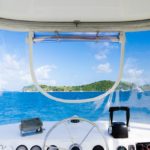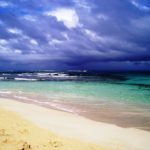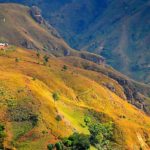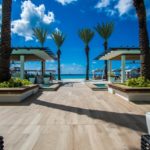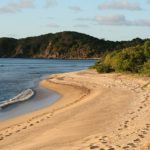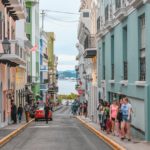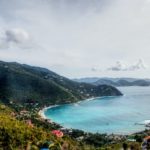Saba, Queen of the Caribbean
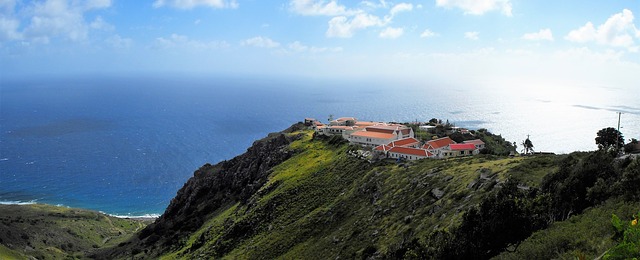
The deep cobalt blue Caribbean Sea was dotted with islands below as we flew over it in a STOL, a short take-off-and-landing 16-seater plane. The pilot approached the island of Saba by circling around the tiny peninsula, the only flat piece of land to be seen. The passengers wondered if there was any way we could land on such a short runway, each end of which fell off steeply into the swirling waters around the black rocks. Five minutes later we were on the ground, stopped within a few feet of the end of the 400-meter runway, the shortest of any commercial airport in the world.
I had arranged for my then seven and nine-year-old children and myself to stay in Cranston’s Antique Inn, where Queen Juliana from Holland had stayed some years earlier. I wanted to climb Mount Scenery, the 2910-foot mountain that rises almost vertically out of the sea, its peak almost always covered in cloud. Tony, the owner of the inn, had a taxi, and I had arranged for him meet us at the airport and drop us at the start of the trail. He took our luggage and would return for us five hours later. We had our lunch, water, rain gear, sunscreen, insect repellent and a mini first-aid kit in our backpacks.
We were fit and did not find the climbing arduous. Where the hard volcanic rock was too steep, the industrious locals had hewn steps into it. There were said to be 365 steps, but we lost count after a while. We came across flat boulders to sit on to admire the spectacular views of the sea and the luscious variety of plants.
Saba, Queen of the Caribbean.
Massive ferns, banana and mango trees formed the upper canopy with every shape, size and shade of green leaf imaginable below, from Elephant’s Ears to feathery sage-green ones. On the ground were more varieties of moss than I had ever seen, and some of the rocks were covered in lichen. The flora ranged from occasional bright-red, wild ginger plants, to bougainvillea of purple and crimson cascading over rocks, and occasional bromeliads growing on the trees.
The mountain was steep, mostly in shade, but sometimes we would emerge from a canopy of leaves into bright sunlight. We had been warned there could be sudden showers, which of course kept all the vegetation lush. However, we did not encounter any rain until we were near the peak. We had already eaten the sandwiches and apples we brought with us from St. Maarten, and were keeping hydrated drinking from our water bottles, so our packs were lighter. Within 100 feet of the top we found ourselves in the cloud. I will never forget my daughter’s delight at being able to stick out her tongue and drink the water in the cloud. It was like walking through fog, and since I had experienced much fog as a child in England, I was interested to see it for a first time through my children’s eyes.
Once we reached the peak, a five-foot-wide area with steep drop-offs on all sides, we started to descend. This proved more challenging. We had to be careful where we stepped because the rock was slippery. Once we were below the cloud, we stopped at a clearing where we had a view 15 miles across the sea to St. Eustatius, known to the locals as Statia. This is another volcanic island with a triangular mountain rising straight out of the Caribbean Sea. Its peak, too, was covered in cloud and we decided we’d like to climb that one the next day.
We came across flat boulders to sit on to admire the spectacular views of the sea and the luscious variety of plants. Massive ferns, banana and mango trees formed the upper canopy with every shape, size and shade of green leaf imaginable below, from Elephant’s Ears to feathery sage-green ones.
Tony was waiting for us with his van, and asked if we would like to tour part of the island on our way back to the inn. He told us about Saba, too, which is one of the Dutch West Indies Windward Islands, along with St. Maarten and St. Eustatius. The island was governed by the French for 12 years, and the English for 18, but it had been Dutch for 345. Most inhabitants lived in the capital, known as The Bottom, an English corruption of de Botte, meaning ‘the bowl’, as the round valley was named in Old Dutch.
There are three other settlements on Saba: Windwardside, St. John’s and Hell’s Gate, and a few individual houses scattered precariously on the mountainside. All the roofs on the island are of red tile, which is very picturesque and provides photogenic views around every bend of the single road on this five-square-mile island. The Road, as it is called, may never have been built but for Josephson Hassel’s stubbornness.
He was descended from one of the original Dutch families sent to colonize the island by the Governor of neighboring St. Eustatius in the 1630s. Both Swiss and Dutch engineers had declared it impossible to build a road on Saba because of the steep mountainous terrain. Hassel sent for a civil engineering correspondence course in 1937, and a year later, embarked on starting to build the first part of the road with some local helpers. It took them five years to build that first section, and the road from end-to-end of the island was not completed until nearly 50 years later, in 1985.
Saba, Queen of the Caribbean.
All government buildings were in The Bottom, which was also home to the Saba University Medical School. In term time, about 200 faculty and medical students swell the usual 2000 population of the island. Cranston’s Antique Inn was in the Main Street, with a number of older wooden houses, some of which had been turned into shops and restaurants. Purple and crimson bougainvillea, hibiscus and yellow trumpet flowers spilled over white picket fences or climbed up walls. The fragrance of wild jasmine filled the air.
Tony’s wife, who had run the inn, had died a few months earlier. We were the only guests that night and were treated like royalty, with a delicious lobster supper at a picnic table in the garden. Tony asked if he could join us. He told us my phone call a month earlier had turned around the deep depression he had fallen into after his wife’s death. He was determined to keep the inn going and was busy learning about all the things his wife had taken care of while he had been doing maintenance and driving his taxi. We noticed he had yet to learn about dusting – there were balls of fluff on the bedroom floor, especially under the bed.
I lost my bid to sleep in Queen Juliana’s four-poster bed with my daughter. My son wanted to sleep in it too, so I ended up on the camp bed in the same room. We all slept soundly and woke to the aroma of bacon and eggs coming from the kitchen on the ground floor. Tony packed us a box lunch and drove us to the airport where we boarded the now-familiar STOL plane to start the next adventure.

